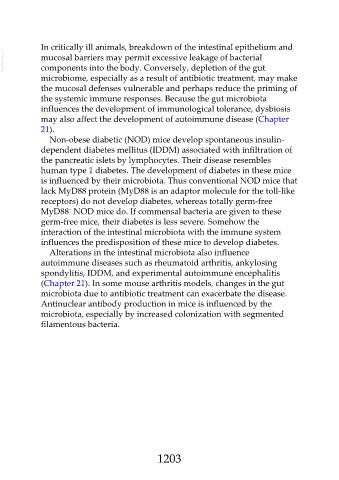Page 1203 - Veterinary Immunology, 10th Edition
P. 1203
In critically ill animals, breakdown of the intestinal epithelium and
VetBooks.ir mucosal barriers may permit excessive leakage of bacterial
components into the body. Conversely, depletion of the gut
microbiome, especially as a result of antibiotic treatment, may make
the mucosal defenses vulnerable and perhaps reduce the priming of
the systemic immune responses. Because the gut microbiota
influences the development of immunological tolerance, dysbiosis
may also affect the development of autoimmune disease (Chapter
21).
Non-obese diabetic (NOD) mice develop spontaneous insulin-
dependent diabetes mellitus (IDDM) associated with infiltration of
the pancreatic islets by lymphocytes. Their disease resembles
human type 1 diabetes. The development of diabetes in these mice
is influenced by their microbiota. Thus conventional NOD mice that
lack MyD88 protein (MyD88 is an adaptor molecule for the toll-like
receptors) do not develop diabetes, whereas totally germ-free
−
MyD88 NOD mice do. If commensal bacteria are given to these
germ-free mice, their diabetes is less severe. Somehow the
interaction of the intestinal microbiota with the immune system
influences the predisposition of these mice to develop diabetes.
Alterations in the intestinal microbiota also influence
autoimmune diseases such as rheumatoid arthritis, ankylosing
spondylitis, IDDM, and experimental autoimmune encephalitis
(Chapter 21). In some mouse arthritis models, changes in the gut
microbiota due to antibiotic treatment can exacerbate the disease.
Antinuclear antibody production in mice is influenced by the
microbiota, especially by increased colonization with segmented
filamentous bacteria.
1203

